CONSTRAINED MOTION
1.1 String constraint :
When the two object are connected through a string and if the string have the following properties :
- The length of the string remains constant i.e., it is inextensible string
- Always remains taut i.e., does not slacks.
Then the parameters of the motion of the objects along the length of the string have a definite relation between them.
Ist format : - (when string is fixed)

The block B moves with velocity v. i.e. each particle of block B moves with velocity v.
If string remain attached to block B it is necessary that velocity of each particle of string is same = v (vs = v)
Now we can say that Block A also moves with velocity v.

: If pulley is fixed then the velocity of all the particles of string is same along the string.
Ex.1
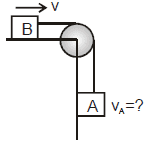
Sol. In the above situation block B is moving with velocity v. Then speed of each point of the string is v along the string.
speed of the block A is also v

Ex.2
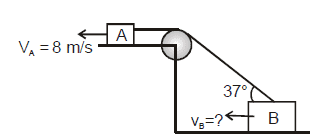
Sol. Q Block A is moving with velocity 8 ms-1.
velocity of every point on the string must be 8m/s along the string.
The real velocity of B is vB. Then the string will not break only when the compoent of vB along string is 8 m/s.

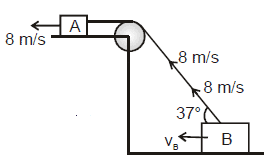
Ex.3 Find out the velocity of block B in a pulley block system as shown in figure.
Sol. In a given pulley block system the velocity of all the particle of string is let us assume v then.
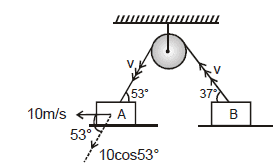
10 m/s is the real velocity of block A then its component along string is v.
⇒ 10 cos 53° = v ...(1)
If vB is the real velocity of block B then it component along string is v then
vBcos37° = v ...(2)

from (1) & (2) vB cos37° = 10 cos53°

Ex.4
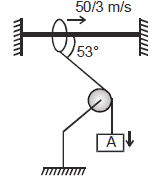
What is the velocity of block A in the figure as shown above.
Sol. The component of velocity of ring along string = velocity of A
= = vA ⇒ vA = 10 m/s
: In the first format only two points of string are attached or touched to moving bodies.
IInd format (when pulley is also moving)
To understand this format we consider the following example in which pulley is moving with velocity vp and both block have velocity vA & vB respectively as shwon in figure.

If we observe the motion of A and B with respect to pulley. Then the pulley is at rest. Then from first format.
vAP = - vBP
(-ve sign indicate the direction of each block is opposite with respect to Pulley)

: - To solve the problem put the values of vA, vB, & vP with sign.
Ex.5
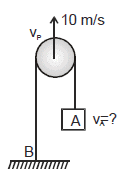
Sol.
Putting vp = 10 ms-1, vB = 0,
we get
vA = 20 ms-1 (upward direction)
Ex.6
Sol. If we take upward direction as ve then
10 =
vB = 25 m/sec (in upward direction)
Ex.7
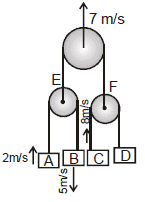
Find out the velocity of Block D
Sol. From 2nd format of constrained motion
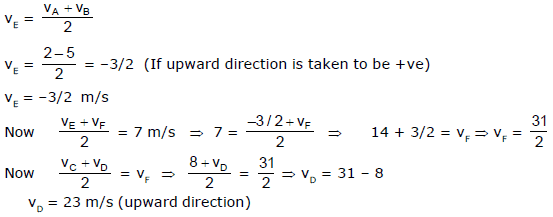
Ex.8

Find the velocity of point G.
Sol. In string ABCD from first format of constrain
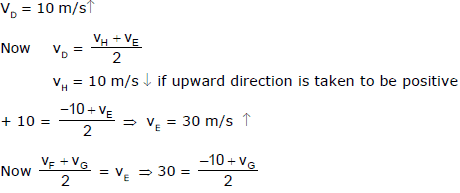
60 + 10 = vG
vG = 70 m/s
: In IInd format three or four Points of the string is attached to the moving bodies.
III format :
solving strategy :
1. First choose the longest string in the given problem which contains the point of which velocity/acceleration to be find out.
2. Now mark a point on the string wherever it comes in contact or leaves the contact of real bodies.
3. If due to motion of a point, length of the part of a string with point is related, increases then its speed will be taken + ve otherwise -ve.
Ex.9
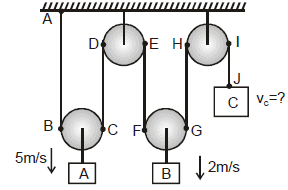
Sol.
Step 1. We choose a longest string ABCDEFGHIJ in which we have to find out velocity of point J (vc)
Step 2. Mark all the point A, B ................
Step 3. Write equation

Ex.10
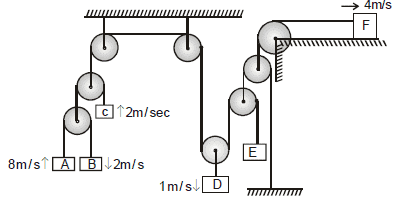
Find out the velocity of block E as shown in figure.
Sol.
Step-1 We first choose the longest string in which point j (block E) lie. (abcdefghij)
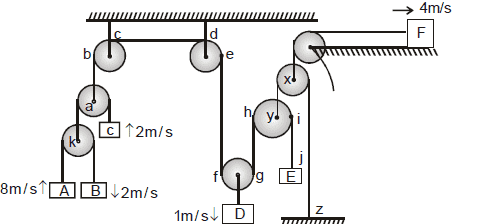
Step 2 : Now write equation according to the velocity of each point (either increase or decrease the length)

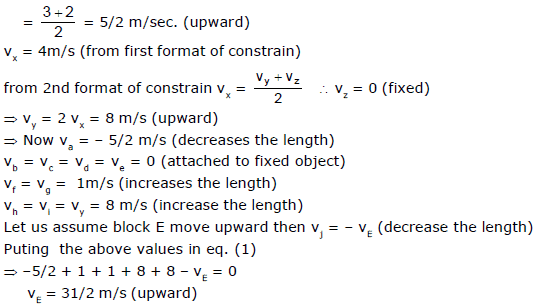
: In the following figure pulley is moving with velocity v at an angle q with the horizontal.

Only v cos q is responsible to increase or decrease the length AB and v sin q is responsible to either decrease or increase the length CD.
* Further solving strategy is same as 3rd format
Ex.11 Find out the relation between acceleration a and b as shown in following figure.
Sol.
Step 1. Mark the points on the string which is attached to the real object (e.f,g,h)
Step 2. Acceleration of each point which are responsible to effect the length of string

2. Wedge Constraint :
Conditions :
(i) Contact must not be lost between two bodies.
(ii) Bodies are rigid.
The relative velocity / acceleration perpendicular to the contact surface of the two rigid object is always zero. Wedge constraint is applicable for each contact.
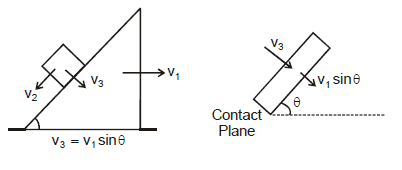
In other words, Components of velocity and acceleration perpendicular to the contact surface of the two objects is always equal if there is no deformation and they remain in contact.
Ex.12 Find the relation between velocity of rod and that of the wedge at any instant in the figure shown.
Sol. Using wedge constraint.

FAQs on NLM - Constrained Motion; Chapter Notes; Class 11; Physics (IIT-JEE and AIPMT)
| 1. What is constrained motion in physics? |  |
| 2. What are the types of constraints in physics? |  |
| 3. How is constrained motion relevant to IIT-JEE and AIPMT exams? |  |
| 4. What is the difference between holonomic and non-holonomic constraints? |  |
| 5. What are some examples of holonomic and non-holonomic constraints? |  |















